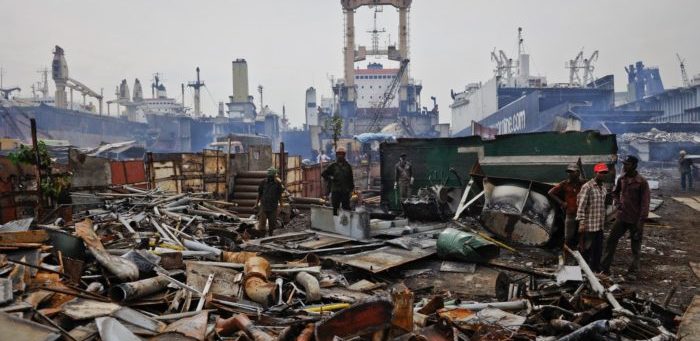Ship Scrapping, Cutting & Marine Scrap
The ship breaking industry plays an important role in recycling outdated ships, contributing to both environmental sustainability and economic benefits. As ships reach the end of their operational lives, they are dismantled in ship breaking yards where valuable materials are salvaged and hazardous substances are properly managed. This process not only recycles raw materials but also helps in reducing the environmental footprint of the maritime industry.
Ship breaking activities are primarily concentrated in regions like South Asia and East Asia, with countries like India, Bangladesh, and Pakistan being major players. These regions offer cost-effective solutions for dismantling ships due to lower labor costs and less stringent environmental regulations compared to the developed world. However, this comes at the expense of working conditions, health risks, and environmental degradation.

The Importance of Ship Recycling
Environmental Benefits
The environmental costs of scrapping ships can be substantial, but environmentally sound recycling practices offer significant benefits. By recycling steel and other materials from ships, the industry reduces the need for mining new raw materials, thereby conserving natural resources and reducing greenhouse gas emissions.
Moreover, ship recycling significantly cuts down on the volume of waste that would otherwise end up in landfills. Ships contain a substantial amount of recyclable materials, including steel, aluminum, and copper. Efficient recycling processes ensure these materials are repurposed, reducing the strain on natural resources and mitigating the environmental costs associated with mining and raw material extraction.
Economic Benefits
The economic benefits of ship recycling are considerable. Ship recycling facilities generate employment, support local economies, and provide raw materials for various industries. The recovered materials, including steel, machinery, and other components, are essential for construction, manufacturing, and other sectors.
In regions like South Asia, the ship breaking industry is a significant source of employment. It provides jobs not only for ship breakers but also for those involved in ancillary industries such as transportation, metal trading, and waste management. This industry is a critical economic driver, contributing to the GDP of these countries and providing livelihoods for thousands of families.
The Process of Marine Scrap Metal Recycling
The Steps In Ship Recycling
- Decommissioning and Preparation
- Decommissioning involves removing hazardous materials and preparing the vessel for dismantling. This step is critical to ensure the safety of ship breaking workers and to minimize environmental contamination. Hazardous substances like asbestos, PCBs, and heavy metals are carefully extracted and disposed of according to strict safety protocols.
- Dismantling
- The ship is brought to a dry dock or a ship recycling yard. Ship breakers use various cutting techniques to disassemble the hull and other structures. High tide is often utilized to beach the ships for easier access. The dismantling process requires precision and expertise to ensure that valuable materials are salvaged efficiently while minimizing waste.
- Material Separation and Processing
- Heavy metals, toxic materials, and other hazardous substances are carefully removed and treated. Recyclable materials like steel are sorted and processed for reuse. Chittagong Steel House in Bangladesh is a notable example of a facility that processes recovered steel. The steel is melted down and repurposed for new construction projects, reducing the demand for new steel production.
Safety and Environmental Standards
The Hong Kong Convention and EU Ship Recycling Regulation set international standards for safe and environmentally sound ship recycling. Compliance with these regulations ensures that yard workers are protected from health risks and that hazardous waste is managed responsibly. These regulations mandate the use of protective gear, proper disposal methods for hazardous materials, and regular monitoring of environmental impact.

Challenges in the Ship and Marine Scrap Metal Industry
Environmental Hazards
Ship breaking activities pose significant environmental hazards, including the release of toxic waste and contamination of coastal areas. Toxic materials like asbestos, heavy metals, and polychlorinated biphenyls (PCBs) must be handled with care to prevent environmental damage. The improper disposal of these substances can lead to soil and water pollution, affecting local communities and marine life.
Regulatory Issues
Compliance with international and national regulations remains a challenge. While the EU Ship Recycling Regulation and the Hong Kong Convention aim to standardize practices, enforcement varies widely. NGO Shipbreaking Platform and Human Rights Watch advocate for stricter regulations and better enforcement to protect workers and the environment. These organizations highlight the need for global cooperation to ensure that ship recycling practices are safe and sustainable across all regions.
Economic Viability
The economic viability of ship recycling can be affected by fluctuating steel prices and the cost of compliance with safety and environmental regulations. Ship recycling yard owners must balance the costs of safe practices with the financial returns from recovered materials. Market volatility can make it challenging for yard owners to predict revenue, impacting their ability to invest in necessary safety and environmental measures.
Innovations in Marine Scrap Metal Recycling
Technological Advancements
Recent years have seen significant innovations in the ship breaking industry. Automation and robotic technologies are improving the efficiency and safety of the dismantling process. These advancements help reduce the exposure of workers to hazardous materials and increase the recovery rate of valuable components. For example, automated cutting machines can dismantle ships more precisely and quickly than manual methods, reducing the risk of accidents and improving productivity.
Sustainable Practices
Sustainable practices, such as the use of dry docks instead of beaching, are gaining traction. Recycling facilities are adopting greener methods to minimize environmental impact and improve worker safety. These practices include better waste management systems and the use of advanced cutting equipment to reduce pollution. Additionally, some facilities are investing in renewable energy sources to power their operations, further reducing their environmental footprint.
Case Studies of Successful Ship Recycling Projects
Example: Alang, India
Alang, located on the coast of India, is one of the world’s largest ship breaking yards. Despite facing criticism for poor working conditions and environmental practices, recent efforts have been made to improve safety standards and compliance with international regulations. Alang’s transformation is a testament to the industry’s potential for reform and sustainable growth. The yard has implemented new safety protocols, invested in better equipment, and established health and medical facilities for workers, significantly improving the overall conditions.
Example: Gadani, Pakistan
Gadani is another major hub for ship recycling. The yard has implemented several safety measures following a severe cyclone that highlighted the need for better disaster preparedness. The introduction of medical facilities and improved occupational health standards has made a significant difference in the well-being of ship breaking workers. These improvements have not only enhanced worker safety but also boosted the yard’s productivity and reputation, attracting more business from international brokers.
Example: China
China has also made significant strides in the ship recycling sector. The country has established several state-of-the-art recycling facilities that adhere to stringent environmental and safety standards. These facilities utilize advanced technologies and sustainable practices, making China a leader in the global ship recycling industry. The government’s support for green initiatives and regulatory compliance has played a crucial role in this progress, setting an example for other countries to follow.
Future Outlook and Trends
Emerging Trends
The future of the ship recycling industry is poised for growth, driven by increasing regulatory pressures and a global push towards sustainability. Emerging trends include the adoption of circular economy principles, where materials are continuously reused, and the integration of advanced technologies to streamline the recycling process. Companies are also exploring the use of digital platforms to enhance transparency and efficiency in the ship recycling supply chain, enabling better tracking of materials and compliance with environmental standards.
Industry Predictions
Experts predict that stricter enforcement of regulations and increased investment in sustainable practices will shape the future of the industry. The international broker market for scrapped ships is expected to grow, providing more opportunities for ship breakers and recycling facilities to thrive.
Additionally, the demand for recycled materials is likely to rise as industries seek more sustainable sources for their raw material needs. This trend is expected to drive innovation and improvements in the ship recycling process, making it more efficient and environmentally friendly.
Final Notes
The ship breaking industry is at a crossroads, balancing economic benefits with environmental and social responsibilities. By embracing innovations and adhering to international standards, the industry can achieve environmentally sound recycling practices that benefit both the economy and the planet. As the world moves towards a more sustainable future, the role of ship recycling facilities will become increasingly important in managing the lifecycle of vessels and contributing to a greener maritime industry.
In conclusion, the ship recycling industry has the potential to transform from a sector often criticized for its environmental and social impacts into a model of sustainability and economic opportunity. Through continued innovation, stricter regulation, and a commitment to best practices, the industry can ensure that the dismantling of ships contributes positively to both local communities and the global environment.

